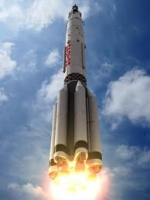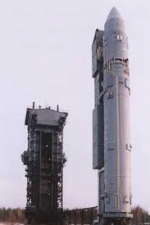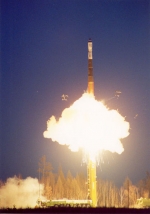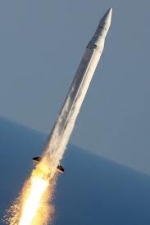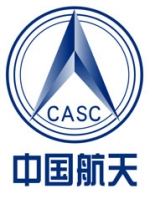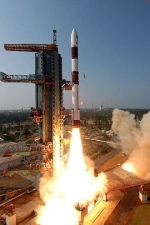Displaying items by tag: launcher
Proton (rocket)
Proton (Прото́н) (formal designation: UR-500) is an expendable launch system used for both commercial and Russian government space launches.
The first Proton rocket was launched in 1965 and the launch system is still in use as of 2012, which makes it one of the most successful heavy boosters in the history of spaceflight. All Protons are built at the Khrunichev plant in Moscow, and then transported for launch to the Baikonur Cosmodrome, where they are brought to the launch pad horizontally and then raised into vertical position for launch.
The launch capacity to low Earth orbit is about 22 tonnes. The geostationary transfer capacity is about 5–6 tonnes.
The commercial launches are marketed by International Launch Services (ILS). In a typical launch of a commercial communications satellite destined for geostationary orbit, a Proton M/Briz-M can place a spacecraft with mass at separation of 4,140 kg into an orbit with an apogee of 35,786 kilometres, a perigee of 6,257 kilometres and an inclination of 19.7°.
Like many Soviet boosters, the names of recurring payloads became associated with their launchers. Thus the moniker "Proton" originates from a series of large scientific Proton satellites, which were among the rocket's first payloads.
Rockot
The Rokot (Russian: Рокот meaning Roar), also transliterated Rockot, is a Russian space launch vehicle that can launch a payload of 1,950 kilograms into a 200 kilometre high Earth orbit with 63° inclination.
It is a derivative of the UR-100N (SS-19 Stiletto) intercontinental ballistic missile (ICBM).
It is supplied and operated by Eurockot Launch Services. The first launches started in the 1990s from Baikonur Cosmodrome out of a silo. Later commercial launches commenced from Plesetsk Cosmodrome using a launch ramp specially rebuilt from one for the Kosmos-3M rocket.
Start-1 rocket
Start-1 is a Russian satellite launch vehicle based on the RT-2PM Topol, a Soviet intercontinental ballistic missile developed by Moscow Institute of Thermal Technology.
The Start-1 launch vehicle derives its name from the Strategic Arms Reduction Treaty (START I) between the United States and the Soviet Union.
The Start-1 rocket is unique amongst launch vehicles in that its launch platform is mobile, allowing for the Start-1 to potentially launch from anywhere. The Start-1 launches from an unmodified Topol Transporter-Erector-Launcher (TEL). The TEL is a massive fourteen-wheeled vehicle, six of which pivot for steering. The launch vehicle is transported and launched inside a mobile Transport and Launch Carrier (TLC) carried by the TEL. The TLC consists of an air-tight composite cylinder that protects the launch vehicle and payload from variations in temperature and humidity. The TLC lays in the middle of the TEL lengthwise and bisects the driver's cab in two.
A version of the Start-1 rocket, simply called Start, was developed in parallel with the Start-1 program. Start differed from Start-1 by using the second stage of the Start-1 twice, giving it a total of five stages. With the extra stage, payload to LEO was increased to 850 kg.
Naro-1 (KSLV-1)
Naro-1 is South Korea's first carrier rocket, which made its maiden flight on 25 August 2009. It is built by KARI, the national space agency of South Korea, and Korean Air, with the first stage provided by Khrunichev (Russia). It was twice launched from the country's new spaceport, the Naro Space Center, but both launches ended in failure.
Its previous name was "Korea Space Launch Vehicle" or KSLV. The official name of the first KSLV rocket, KSLV-I, is Naro, which is the name of the region in which Naro Space Center is located.
The Naro-1 rocket is based on the Universal Rocket Module, the first stage of the Russian Angara rocket, combined with a solid-fueled second stage built by South Korea.
Energia Launcher
Energia (Russian: Энергия, Energiya, "Energy") was a Soviet rocket that was designed by NPO Energia to serve as a heavy-lift expendable launch system as well as a booster for the Buran spacecraft.
The Energia used four strap-on boosters powered by a four-nozzle RD-170 engine burning with kerosene/LOX, and a central core stage with 4 one-chamber RD-0120 (11D122) engines fueled with liquid hydrogen/LOX.
The launch system had two functionally different operational variants: Energia-Polyus, the initial test configuration, in which the Polyus system was used as a final stage to put the payload into orbit, and Energia-Buran, in which the Buran spacecraft was the payload and the source of the orbit insertion impulse.
The rocket had the capacity to place about 100 metric tons in Low Earth orbit, up to 20 t to the geostationary orbit and up to 32 t to the lunar mission trajectory.
China Aerospace Science and Technology Corporation (CASC)
The China Aerospace Science and Technology Corporation (CASC) is the main contractor for the Chinese space program.
It is state-owned and has a number of subordinate entities which design, develop and manufacture a range of spacecraft, launch vehicles, strategic and tactical missile systems, and ground equipment. It was officially established in July 1999 as part of a Chinese government reform drive, having previously been one part of the former China Aerospace Corporation. Various incarnations of the program date back to 1956.
Polar Satellite Launch Vehicle (PSLV)
The Polar Satellite Launch Vehicle, commonly known by its abbreviation PSLV, is an expendable launch system developed and operated by the Indian Space Research Organisation (ISRO). It was developed to allow India to launch its Indian Remote Sensing (IRS) satellites into Sun synchronous orbits, a service that was, until the advent of the PSLV, commercially viable only from Russia. PSLV can also launch small size satellites into geostationary transfer orbit (GTO). The PSLV has launched 52 satellites (26 Indian satellites and 26 foreign satellites) into a variety of orbits to date (May 2012).
Alliant Techsystems Inc. (ATK)
Alliant Techsystems Inc., most commonly known as ATK, is one of the largest aerospace and defense companies in the United States with more than 18,000 employees in 22 states, Puerto Rico and internationally.
ATK is a pioneer in solid rocket propulsion systems, strategic missiles, missile defense, lightweight space deployables, solar arrays and satellite thermal management systems, while developing new technologies for small and micro satellites.
ATK’s human space capability includes solid rocket boosters, engineering services, astronaut tools and solar arrays. Its Reusable Solid Rocket Motors (RSRM) have been propelling the space shuttle since its beginning. In the commercial market ATK offers its Liberty Launch Vehicle, which includes a five-segment solid rocket first stage and liquid fueled upper stage to transport astronauts to the International Space Station (ISS). ATK is also developing the launch abort and attitude control motors for the Ares I Orion crew capsule, as well as the circular shape ultra-light solar arrays that will power the capsule.
Propulsion systems for strategic missiles and missile defense systems is a core capability. ATK provides all three stages for the Minuteman III and Trident II D-5 missiles. In the missile defense arena, ATK also provides all three stages for the Ground-based Missile Defense (GMD) system.
ATK’s involvement with Operationally Responsive Space (ORS) extends from launch vehicles to small and micro satellites. With ATK’s versatile product line of solid rocket motors, multiple launch vehicle configurations can be developed to support specific mission requirements.
The company’s small satellite capabilities include responsive development, constellation solutions, single-string and redundant avionics architectures. ATK also provides commercial boosters for the Delta rockets. The company is teamed with Lockheed Martin to provide the commercial Athena launch vehicle.
NASA - Kennedy Space Center
The John F. Kennedy Space Center (KSC) is the NASA installation that has been the launch site for every United States human space flight since 1968. Although such flights are currently on hiatus, KSC continues to manage and operate unmanned rocket launch facilities for America's civilian space program from three pads at the adjoining Cape Canaveral Air Force Station. Its iconic Vehicle Assembly Building (VAB) is the fourth-largest structure in the world by volume and was the largest when completed in 1965.
SpaceX
Space Exploration Technologies Corporation, or SpaceX, is a space transport company headquartered in Hawthorne, California, USA.
It was founded in 2002 by former PayPal entrepreneur Elon Musk. It has developed the Falcon 1 and Falcon 9 space boosters, both of which are built with a goal of becoming reusable launch vehicles. SpaceX has also launched the Dragon spacecraft to be flown into orbit by the Falcon 9 launch vehicle. On 25 May 2012, SpaceX made history as the world's first privately held company to send a cargo load, the Dragon spacecraft, to the International Space Station.
SpaceX designs, tests and fabricates the majority of its components in-house, including the Merlin, Kestrel, and Draco rocket engines used on the Falcon launch vehicles and the Dragon spacecraft. In 2006, NASA awarded the company a Commercial Orbital Transportation Services (COTS) contract to design and demonstrate a launch system to resupply cargo to the International Space Station (ISS). On 9 December 2010, the launch of the COTS Demo Flight 1 mission, SpaceX became the first privately funded company to successfully launch, orbit and recover a spacecraft. On 22 May 2012, SpaceX's Falcon 9 rocket carried the unmanned Dragon capsule into space, marking the first time a private company has sent a spacecraft to the space station. The unmanned, cone-shaped capsule became the first privately built and operated vehicle to ever dock to the orbiting outpost.

